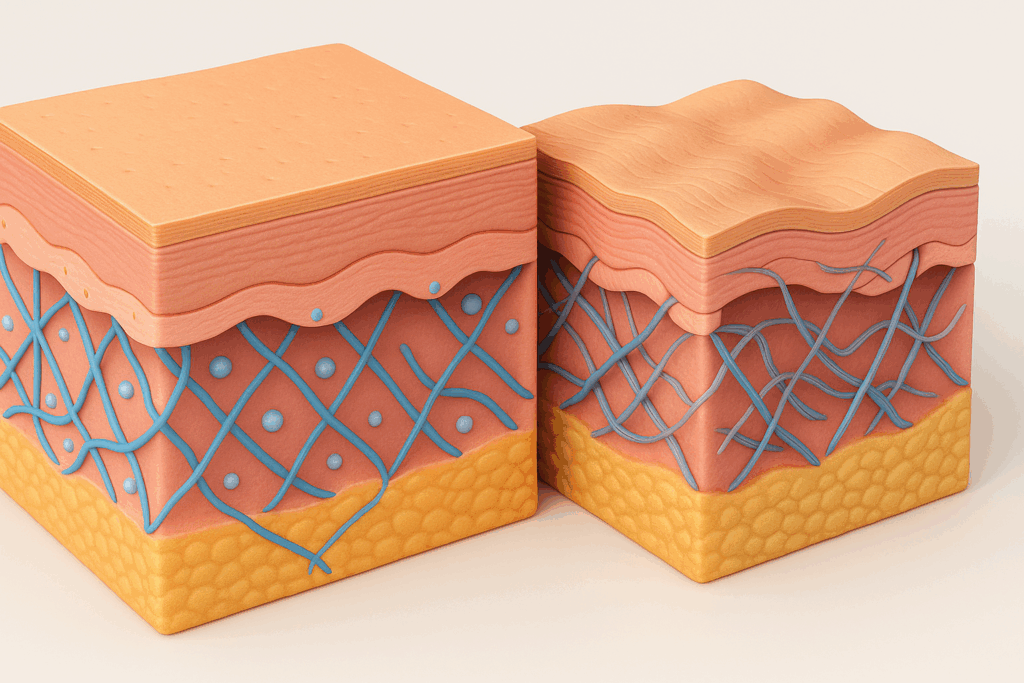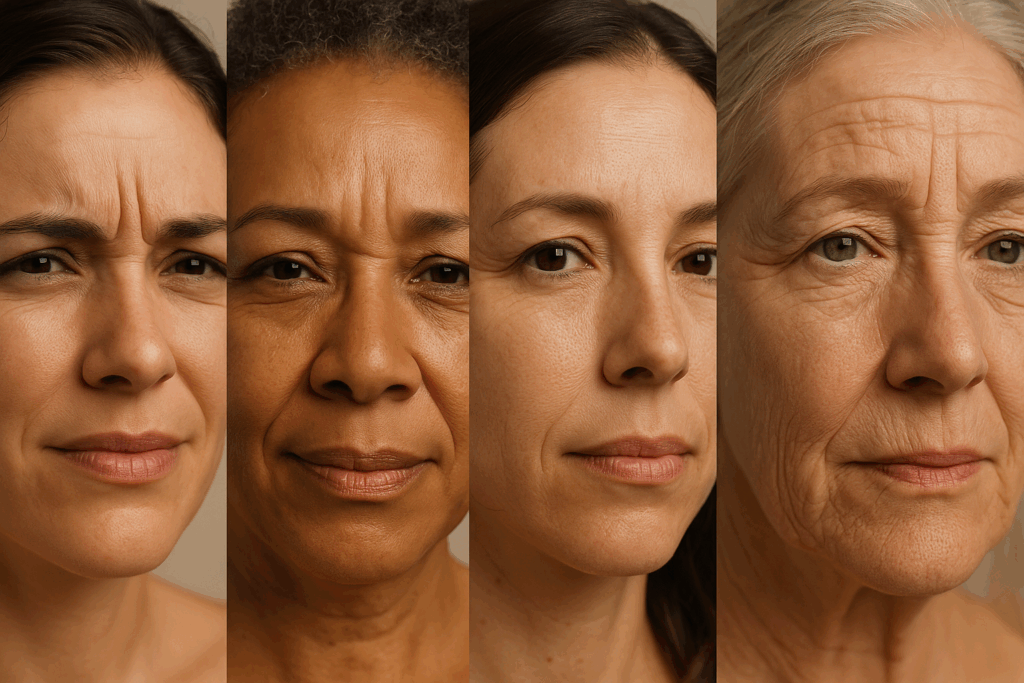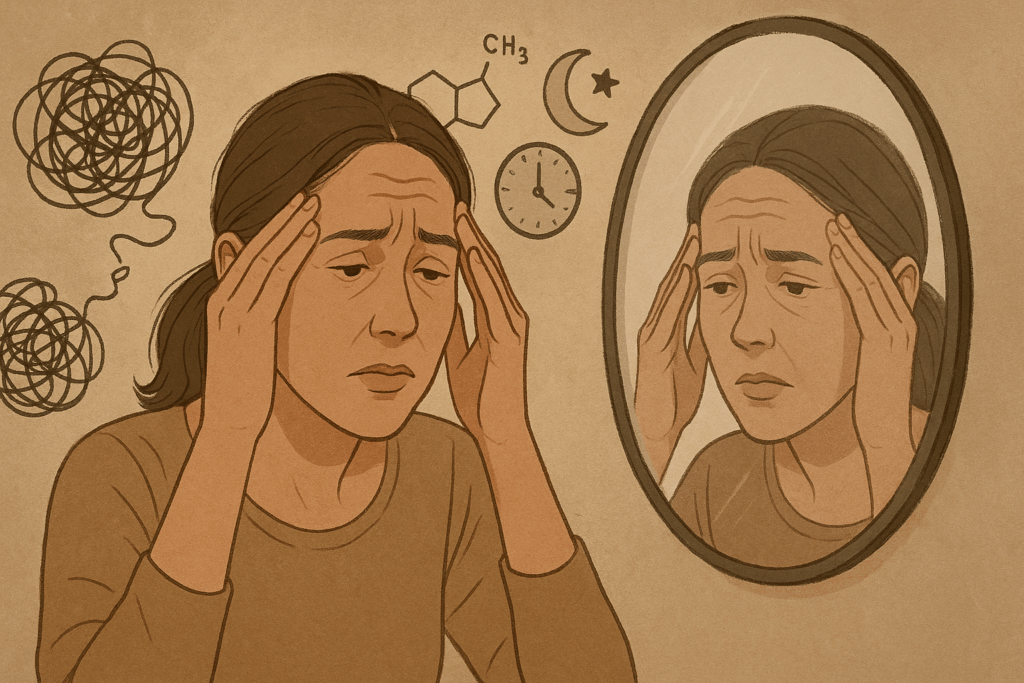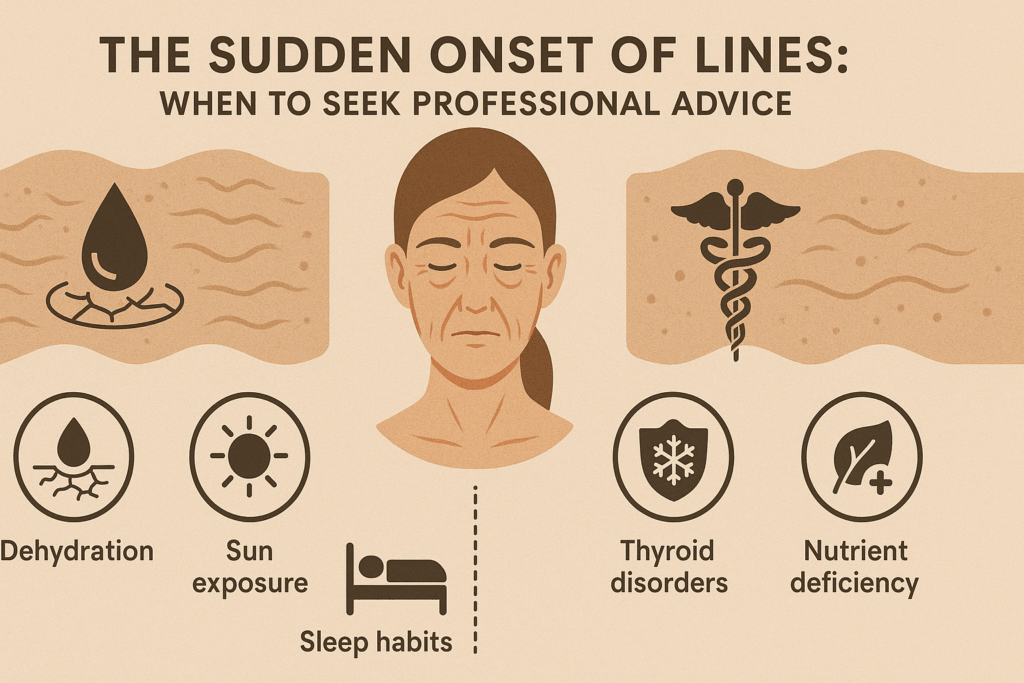For many people, the appearance of wrinkles is an expected consequence of aging. However, when skin creases appear abruptly, it can provoke confusion, concern, and an urgent search for answers. The sudden development of facial lines can seem mysterious, especially when they appear overnight or within a short span of time. To understand why this might happen, it is important to explore the medical, environmental, and psychological influences that can accelerate skin aging and trigger unexpected wrinkling.
You may also like: How to Choose Skin Care for Fine Lines: Evidence-Based Tips for Healthier, Younger-Looking Skin
Understanding the Medical Term of Wrinkle and What Wrinkles Really Mean
Before examining what causes wrinkles to appear suddenly, it is helpful to understand the wrinkle meaning from a medical perspective. Medically, a wrinkle is defined as a fold, ridge, or crease in the skin that results from a loss of elasticity and structural proteins like collagen and elastin. These fine lines on skin often begin subtly, forming around areas of frequent muscle movement, such as the forehead, eyes, and mouth. Over time, these initial lines can deepen into more prominent skin creases. The medical term of wrinkle is “rhytide,” a word derived from Greek, referring to folds or ridges.
For dermatologists and skin specialists, wrinkles signify more than aesthetic changes. They can reflect underlying biological aging, chronic stress, nutritional deficiencies, or dermatologic conditions. In this context, to define wrinkle involves recognizing its multifactorial origins. A wrinkle is not simply a cosmetic imperfection; it is a signal of deeper physiological processes occurring within the skin’s layers. When these processes accelerate or shift abruptly, they can lead to the sudden wrinkling of the skin.

What Causes Wrinkles to Appear Suddenly?
The question “why do I suddenly have wrinkles?” often implies that something in the individual’s internal or external environment has shifted significantly. While age-related skin changes usually unfold gradually, several factors can provoke rapid skin aging. These include dehydration, stress, ultraviolet (UV) radiation, abrupt hormonal changes, nutritional deficits, sleep disturbances, and chronic illnesses.
One common culprit is acute dehydration. When the skin loses water content, it becomes less plump, making existing lines more visible and creating new fine lines on skin, especially around the eyes and mouth. Sleep deprivation also contributes to this effect by impeding the body’s ability to repair tissue damage overnight. Furthermore, cortisol levels—often elevated during stress—can break down collagen, resulting in deeper lines and wrinkles.
UV exposure remains one of the most powerful accelerators of aging. Even brief, unprotected sun exposure can damage skin cells and lead to what causes wrinkles on face to emerge more noticeably. Photoaging, the process by which UV rays degrade collagen and elastin, can generate skin creases with surprising speed, especially when cumulative sun damage reaches a tipping point.
Hormonal fluctuations, particularly declines in estrogen, may also underlie sudden wrinkling. These hormonal shifts commonly occur during menopause but can be triggered earlier by stress, illness, or medical treatments. When estrogen levels fall, skin loses hydration, volume, and elasticity, making lines in face more apparent. In these cases, the sudden wrinkling of the skin is a symptom of an internal systemic change.

When Do Wrinkles Start? Age Isn’t Always the Answer
While most people associate wrinkles with aging, the question of when do wrinkles start is not always linked to chronological age. Some individuals begin to notice wrinkles at 25 or even earlier, particularly if they have spent significant time in the sun or have high-stress lifestyles. Wrinkles at 25 may be early signs of skin responding to environmental stressors or a reflection of inherited skin characteristics.
The idea that wrinkle formation begins only in middle age is outdated. In fact, dermatologists often see forehead wrinkles at 25, especially in people with expressive facial movements or inadequate sun protection habits. Genetic predisposition plays a significant role, but lifestyle choices are equally important in determining what age wrinkles appear. Smokers, for example, often show signs of wrinkling much earlier than nonsmokers, particularly around the mouth and eyes.
So when do you start getting wrinkles? The answer varies widely. While collagen production begins to slow in the mid-20s, visible changes can appear earlier or later depending on the interplay of genetics, skincare routines, diet, hydration, and environmental exposures. For some, even mild dehydration or sleep disruptions can cause forehead lines at 25, making the skin appear older than it actually is.

How Do Wrinkles Form? The Science Behind Skin Aging
To understand how sudden changes occur, we must consider how do wrinkles form under normal circumstances. Wrinkles form as the skin loses its ability to regenerate and maintain structural proteins like collagen and elastin. Over time, skin cells divide more slowly, the dermal layer thins, and the connective tissue matrix becomes less resilient. These changes contribute to sagging and the appearance of lines and wrinkles.
In youth, skin appears smooth and resilient due to a dense network of collagen fibers and high levels of hyaluronic acid, which helps retain moisture. With age and exposure to damaging factors, these structural supports deteriorate. This process leads to fine lines on skin, which eventually deepen into more pronounced creases. The repetitive motion of facial muscles also contributes to the formation of dynamic wrinkles, such as crow’s feet and forehead lines.
However, sudden wrinkling of the skin can occur when these processes are accelerated or disrupted. For example, abrupt weight loss can cause facial volume loss, revealing previously hidden skin creases. Similarly, acute illness or systemic inflammation can affect the skin’s integrity, triggering changes typically associated with aging. In such cases, the lines on the face meaning extend beyond surface-level concerns to reflect overall health status.

Types of Wrinkles: Not All Lines Are the Same
It is essential to recognize the types of wrinkles that may appear, especially when wrinkling happens suddenly. Wrinkles are generally categorized into dynamic and static types. Dynamic wrinkles result from repeated facial expressions, while static wrinkles are present even when the face is at rest. Over time, dynamic wrinkles can become static, especially when skin resilience is compromised.
Another distinction includes fine lines on skin versus deeper skin creases. Fine lines are superficial and often reversible with hydration and skincare interventions, whereas deeper creases may require dermatological treatments such as microneedling or laser resurfacing. Wrinkles at 30, for instance, often begin as fine lines but can deepen if underlying causes are not addressed.
In medical dermatology, additional wrinkle types are classified based on location and etiology. Forehead lines, crow’s feet, nasolabial folds, and marionette lines each have distinct origins and contributing factors. Knowing the types of wrinkles helps both patients and clinicians target treatments more effectively. For example, forehead lines at 25 may respond well to lifestyle changes and topical retinoids, while deeper static lines may require more invasive approaches.

Environmental Triggers and Lifestyle Factors Behind Sudden Wrinkling
Even for individuals with previously smooth skin, environmental exposures can abruptly alter the skin’s appearance. Among these, sun damage is the most critical contributor. Cumulative exposure to UV radiation breaks down collagen, reduces skin elasticity, and creates oxidative stress that accelerates aging. This is why many people begin to notice what causes wrinkles and sagging skin after a vacation or outdoor event without adequate sun protection.
Pollution, smoke exposure, and harsh skincare products can also lead to sudden wrinkling. Airborne toxins and chemical irritants can degrade the skin’s protective barrier and cause inflammation, making the skin more vulnerable to damage. Additionally, overexfoliation and misuse of retinol products can weaken the skin and lead to the sudden appearance of lines and wrinkles.
Sleep quality and posture also play surprising roles. Sleeping on the side or stomach, especially with rough pillowcases, can cause skin to fold in repetitive ways, leading to sleep lines that become permanent over time. If someone notices wrinkles at 30 despite good skincare, evaluating sleep hygiene and sleeping positions may uncover overlooked contributors.

The Role of Mental Health and Stress in Skin Aging
While the physical mechanisms of aging are well-documented, the mind-skin connection is an emerging field of interest. Psychological stress has measurable effects on the skin, and many individuals report sudden skin aging during times of emotional turmoil. This link is especially relevant for readers interested in the intersection of mental health and skin wellness.
Chronic stress elevates cortisol levels, which in turn accelerates collagen breakdown, impairs wound healing, and contributes to inflammation. These biochemical changes can lead to the sudden wrinkling of the skin, particularly in areas of frequent muscle tension like the forehead and mouth. Moreover, stress often disrupts sleep patterns, leading to a vicious cycle of poor skin regeneration and increased oxidative stress.
For individuals experiencing forehead wrinkles at 25 or other early signs of aging, assessing stress levels and emotional well-being may be as important as evaluating skincare routines. The presence of lines in face does not only reflect aging; it can also mirror the burdens carried mentally and emotionally. This perspective reinforces the importance of holistic health strategies that include mental wellness alongside topical treatments.
What Age Does Wrinkles Start? A Nuanced Answer
The idea of pinpointing what age do you start getting wrinkles oversimplifies a complex process. Skin aging does not begin on a specific birthday; rather, it is the result of cumulative influences over time. Nonetheless, studies show that collagen production typically begins to decline in the mid-20s, which aligns with the onset of early signs such as fine lines or forehead lines at 25.
The visibility of wrinkles depends not just on age but also on factors like hydration, skin type, sun exposure, stress, and genetic predisposition. Therefore, the answer to what age wrinkles appear will vary widely. Some individuals show signs of wrinkling as early as their teens due to sun damage or inherited conditions, while others maintain smooth skin well into their 40s.
Understanding this variability is crucial in avoiding unnecessary anxiety. Seeing wrinkles at 25 is not inherently abnormal; rather, it is a signal to examine lifestyle and skincare habits more closely. Similarly, noticing wrinkles at 30 does not mean premature aging—it may simply be the skin responding to environmental or hormonal changes. In this context, a wrinkled person is not necessarily unhealthy or aged but may be experiencing normal variations in dermal biology.

The Sudden Onset of Lines: When to Seek Professional Advice
In some cases, the sudden appearance of wrinkles may point to medical conditions that require further evaluation. Autoimmune disorders, thyroid imbalances, and connective tissue diseases can all affect skin integrity. For example, individuals with lupus or scleroderma may notice rapid skin thinning and increased skin creases.
Similarly, nutritional deficiencies—particularly in vitamin C, vitamin E, and essential fatty acids—can impair skin repair and lead to visible changes. These nutrients play critical roles in collagen synthesis and antioxidant defense, making their absence a potential factor in what causes wrinkles and sagging skin. If someone notices a rapid shift in their skin’s appearance without a clear environmental trigger, consulting a dermatologist or healthcare provider is prudent.
Medical professionals can perform diagnostic tests, assess hormonal levels, and recommend targeted treatments to restore skin health. Whether it’s sudden wrinkling of the skin or progressive changes over time, early intervention improves outcomes and helps distinguish between benign cosmetic concerns and signs of deeper health issues.
Recognizing the Lines on the Face Meaning in Health and Beauty
From a cultural standpoint, lines on the face meaning has evolved. Once seen solely as indicators of aging, they are increasingly recognized as markers of life experience, emotional expression, and inner resilience. Nonetheless, the desire to understand and prevent premature wrinkling remains strong, and rightly so, as skin health often reflects systemic well-being.
Fine lines, skin creases, and wrinkles are not inherently undesirable, but their sudden appearance can serve as a useful prompt to assess one’s lifestyle, nutrition, and mental health. In modern dermatology, line and wrinkles are no longer treated as isolated aesthetic issues but are understood within the broader context of holistic health.
Ultimately, to define wrinkle in today’s world is to see it as a reflection not just of biology but of environment, psychology, and time. Recognizing this interconnectedness empowers individuals to take proactive steps toward better skin health, whether through medical care, emotional balance, or preventive skincare routines.
Frequently Asked Questions: Understanding Sudden Wrinkles and Skin Changes
1. Can emotional trauma or chronic stress lead to sudden wrinkling of the skin?
Yes, emotional trauma and prolonged stress can significantly impact skin health, sometimes resulting in sudden wrinkling of the skin. Chronic psychological stress elevates cortisol levels, which accelerates the degradation of collagen and elastin, key proteins responsible for skin elasticity. People experiencing high stress may develop fine lines on skin more quickly, especially around the eyes and forehead where muscle tension accumulates. Additionally, trauma may disrupt sleep patterns and eating habits, leading to nutrient deficiencies that further compromise the skin. This explains why some individuals might suddenly ask, “why do I suddenly have wrinkles?” when the root cause is psychological rather than purely dermatological.
2. What age do wrinkles start for people with darker skin tones, and does melanin provide any protection?
Melanin does offer a degree of natural protection against UV-induced damage, which influences when wrinkles start to appear in individuals with darker skin tones. On average, people with higher melanin levels tend to show signs of aging later than those with fairer skin. However, while deeper skin tones may delay the onset of what causes wrinkles and sagging skin, they are not immune to it. Environmental stressors, lifestyle factors, and genetics still play a role in determining what age wrinkles appear. That said, people of color often experience wrinkle formation differently, with more emphasis on skin texture and volume loss rather than visible lines in the face.
3. Are forehead lines at 25 ever considered normal, or should they always be a concern?
Forehead lines at 25 can be a normal part of early aging, especially for individuals with expressive facial habits or genetic predisposition. However, they can also indicate early onset of environmental or behavioral stressors such as UV exposure, poor hydration, or nutritional imbalances. While they may not necessarily signal a medical problem, they often serve as a cue to evaluate skincare routines and lifestyle habits. The question of when do you start getting wrinkles varies widely by individual, but forehead wrinkles at 25 may simply be a visual reminder that skin care should start early. For those with deeper or rapidly developing lines, consulting a dermatologist may offer preventive strategies.
4. How do frequent dieting and rapid weight loss contribute to the sudden appearance of wrinkles?
Rapid weight loss can lead to sudden wrinkling of the skin due to the loss of facial fat and volume, which otherwise supports a youthful contour. When weight is lost quickly, the skin doesn’t always have time to adjust, resulting in sagging and skin creases. Nutrient depletion from restrictive diets can also impair collagen synthesis, weakening the skin’s structural integrity. People who notice wrinkles at 30 or younger following significant weight changes are often seeing the dermal impact of these metabolic shifts. Understanding what causes wrinkles in such cases involves looking beyond aging and into body composition and nutrient intake.
5. Are there new dermatological treatments targeting specific types of wrinkles with greater precision?
Yes, innovations in dermatology now allow for more targeted treatment of different types of wrinkles. Technologies like fractional lasers, microfocused ultrasound, and radiofrequency microneedling are being used to address fine lines on skin and deeper folds more precisely. These treatments work by stimulating collagen and elastin production in targeted areas, improving skin texture and elasticity. Knowing the types of wrinkles involved—dynamic versus static, or surface-level versus structural—helps clinicians choose the most appropriate approach. As such, defining wrinkle types accurately can guide better treatment outcomes and delay what age wrinkles appear visually.
6. Can poor indoor air quality affect skin aging and contribute to sudden wrinkling?
Absolutely. Indoor air pollutants such as volatile organic compounds (VOCs), dust, and even central heating systems can dry out the skin and increase oxidative stress. Over time, this leads to dullness, irritation, and skin creases, especially if windows are rarely opened or filters are not maintained. People living in urban environments or spending extended time indoors may notice that they suddenly develop wrinkles or that existing lines in face deepen more quickly. To reduce exposure, consider air purifiers, humidifiers, and indoor plants that help improve air quality and skin health simultaneously. Understanding what causes wrinkles on face must include not just sun exposure but also the air we breathe daily.
7. Do wrinkles at 25 mean I’m aging prematurely, or could it be something else entirely?
Wrinkles at 25 don’t necessarily mean you’re experiencing premature aging in a clinical sense. Instead, they may signal skin that is reacting early to environmental stressors like UV radiation, screen exposure, or sleep disruption. In some cases, these early signs may result from a thin skin type that naturally reveals fine lines on skin more quickly. It’s also worth considering hormonal influences or nutritional deficiencies when asking what causes skin wrinkles at a younger age. Rather than seeing these lines as permanent signs of aging, they should be viewed as feedback from the skin that it may need additional support.
8. Is there a connection between gut health and the formation of wrinkles?
Emerging research suggests that gut health may influence skin aging by affecting nutrient absorption, systemic inflammation, and oxidative stress. Imbalances in the gut microbiome can impair the absorption of key nutrients like vitamin C and zinc, both of which are vital for collagen formation and skin repair. Chronic gut inflammation may also lead to systemic inflammation, which accelerates the skin’s aging process. While the gut-skin connection isn’t the only factor in what causes wrinkles and sagging skin, it is an increasingly recognized one. As a result, improving digestive health could support the skin from the inside out and delay the age at which wrinkles appear.
9. Can the sudden use or discontinuation of skincare products cause skin changes that resemble wrinkles?
Yes, abruptly starting or stopping certain skincare products—especially those containing active ingredients like retinoids or exfoliants—can shock the skin and mimic or intensify wrinkles. When the skin’s barrier is disrupted, moisture loss can exaggerate fine lines on face, and inflammation may deepen skin creases. Discontinuation of hyaluronic acid serums, for example, can cause a noticeable loss in plumpness, making users feel like they suddenly developed wrinkles. To prevent this, skincare changes should be made gradually, and barrier-repairing ingredients like ceramides or niacinamide can be used during transitions. This highlights how product behavior plays a role in how and when do wrinkles start to appear.
10. How do social perceptions of a wrinkled person impact psychological well-being?
The appearance of wrinkles—especially when they occur suddenly—can carry social and psychological weight beyond their physical presence. In many cultures, a wrinkled person may be perceived as older, less energetic, or less vibrant, which can influence personal confidence and professional interactions. This perception can lead to anxiety, self-consciousness, or even avoidance behaviors, particularly among those who experience forehead lines at 25 or wrinkles at 30. Recognizing that lines in face also reflect a person’s emotional journey and life experiences can help shift societal views toward a more compassionate perspective. Educating others on what are fine lines on face and what causes wrinkles on face fosters better understanding and reduces the stigma surrounding visible aging.
Conclusion: Embracing the Why Behind Sudden Wrinkles for Better Skin Health
The question “why do I suddenly have wrinkles?” is more than a cosmetic concern. It is an invitation to understand the complex and multifaceted nature of skin aging. Whether triggered by dehydration, stress, hormonal shifts, or environmental exposures, sudden changes in the skin often mirror deeper imbalances in the body and mind.
By learning what causes skin wrinkles and identifying when wrinkles start, individuals can better respond to these signs with insight and intention. Recognizing types of wrinkles and understanding their meaning allows for more effective and personalized approaches to skincare and wellness. Rather than fearing the appearance of skin creases, we can use them as opportunities to examine our health, habits, and holistic well-being.
Whether you’re noticing wrinkles at 25 or suddenly seeing new lines in your 40s, remember that your skin is a dynamic organ that communicates both your past and your present. With attention to internal and external care, it is possible not only to manage these changes but also to embrace them as part of a larger journey toward health and self-awareness.
Was this article helpful? Don’t let it stop with you. Share it right now with someone who needs to see it—whether it’s a friend, a colleague, or your whole network. And if staying ahead on this topic matters to you, subscribe to this publication for the most up-to-date information. You’ll get the latest insights delivered straight to you—no searching, no missing out
Further Reading:
Wrinkles & Fine Lines: Types, Causes & Prevention
Skin Care and Aging – National Institute on Aging
Skin Disorders: Pictures, Causes, Symptoms, and Treatment
Disclaimer
The information contained in this article is provided for general informational purposes only and is not intended to serve as medical, legal, or professional advice. While Health11News strives to present accurate, up-to-date, and reliable content, no warranty or guarantee, expressed or implied, is made regarding the completeness, accuracy, or adequacy of the information provided. Readers are strongly advised to seek the guidance of a qualified healthcare provider or other relevant professionals before acting on any information contained in this article. Health11News, its authors, editors, and contributors expressly disclaim any liability for any damages, losses, or consequences arising directly or indirectly from the use, interpretation, or reliance on any information presented herein. The views and opinions expressed in this article are those of the author(s) and do not necessarily reflect the official policies or positions of Health11News.